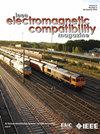导线的增强型多导体传输线模型
IF 2.5
3区 计算机科学
Q3 ENGINEERING, ELECTRICAL & ELECTRONIC
IEEE Transactions on Electromagnetic Compatibility
Pub Date : 2025-03-17
DOI:10.1109/TEMC.2025.3545336
引用次数: 0
摘要
传输线(TL)模型几十年来一直被用来描述信号和功率沿导线的传播。众所周知,它是基于准横向电磁(TEM)传播假设,并且只有当导体之间的距离同时远远小于它们的长度和信号的最小特征波长时才准确。另一方面,当这些假设不匹配时,由于所得模型的计算复杂性,采用全波方法研究导体束是不可行的。必须寻求一种折衷的解决方案,以更准确地表示电磁现象,而不会引起难以处理的计算复杂性。多年来,人们提出了许多方法来处理这个问题。在这项工作中,我们的目标是将一种优雅而严谨的特定方法扩展到N导体TLs,但目前仅限于双导体TLs。当标准TL理论的假设不再匹配时,这允许更严格地模拟3-D效应,例如传播。同时,所得到的模型保留了一维模型的简洁性,并且非常适合与三维模型集成,因为它将假设无穷大作为参考。作为进一步的结果,邻近效应是通过诉诸电荷密度的谐波展开来建模的。通过三个实例验证了该方法的有效性。特别要强调的是,当tl的“标准”模型的假设得到满足时,它将返回标准模型结果。相反,当标准模型不再适用时,它在高频率下返回不同的结果。本文章由计算机程序翻译,如有差异,请以英文原文为准。
An Enhanced Multiconductor Transmission Line Model for Conducting Wires
The transmission line (TL) model has been used for decades to describe the propagation of signals and power along conducting wires. It is also well-known that it is based on the quasi-transverse electromagnetic (TEM) propagation hypothesis and is only accurate if the distance between the conductors is much smaller simultaneously than their length and the smallest characteristic wavelength of the signals. On the other hand, when these hypotheses are not matched, adopting full-wave methods for studying conductor bundles is not feasible due to the computational complexity of the resulting models. A compromise solution must be sought to represent electromagnetic phenomena more accurately without incurring an intractable computational complexity. Many approaches have been proposed over the years to handle this problem. In this work, we aim to extend to $N$
求助全文
通过发布文献求助,成功后即可免费获取论文全文。
去求助
来源期刊
CiteScore
4.80
自引率
19.00%
发文量
235
审稿时长
2.3 months
期刊介绍:
IEEE Transactions on Electromagnetic Compatibility publishes original and significant contributions related to all disciplines of electromagnetic compatibility (EMC) and relevant methods to predict, assess and prevent electromagnetic interference (EMI) and increase device/product immunity. The scope of the publication includes, but is not limited to Electromagnetic Environments; Interference Control; EMC and EMI Modeling; High Power Electromagnetics; EMC Standards, Methods of EMC Measurements; Computational Electromagnetics and Signal and Power Integrity, as applied or directly related to Electromagnetic Compatibility problems; Transmission Lines; Electrostatic Discharge and Lightning Effects; EMC in Wireless and Optical Technologies; EMC in Printed Circuit Board and System Design.

 求助内容:
求助内容: 应助结果提醒方式:
应助结果提醒方式:


